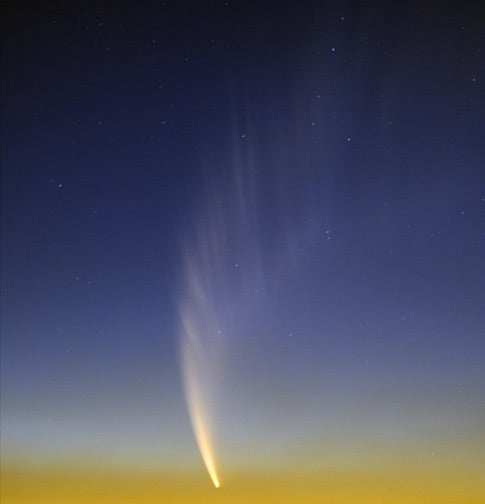Comets are made of the most primitive stuff in the solar system. As hunks of rock and ice that never coalesced into more planets, they give researchers clues to the evolution of solar systems.
So a chance encounter between spacecraft Ulysses and Comet McNaught’s ion tail has scientists in the University of Michigan’s College of Engineering marveling at a stroke of luck and some surprising data.
The NASA/European Space Agency spacecraft is on a mission to study the Sun’s polar regions, and it carries an instrument run by U-M professors. In February, it flew through McNaught’s ion tail 160 million miles from the comet’s core.
Instrument readings showed there was “complex chemistry” at play, said U-M space science professor George Gloeckler, second author of a paper on the findings published October 1 in Astrophysical Journal.
Gloeckler is the principal investigator on the Solar Wind Ion Composition Spectrometer (SWICS) aboard Ulysses, which measured the composition and speed of the comet tail and solar wind. The solar wind consists of high-speed streams of plasma that emanate from the sun’s outer atmosphere. Not only did SWICS detect unexpected ions in the comet tail, it found that the tail had a major impact on the surrounding solar wind.
For the first time at a comet, researchers detected O3+ oxygen ions (atoms of oxygen with a positive charge because they have five electrons instead of eight). This suggests that the solar wind ions, originally missing most of their electrons, picked up some of their missing electrons when they passed through McNaught’s atmosphere. The comet served as a source of electrons, said Michael Combi, a U-M space science professor who is an author of the paper.
SWICS also found that even at 160 million miles from the comet’s nucleus, the tail had slowed the solar wind to half its normal speed. The solar wind would usually be about 435 miles per second at that distance from the sun, but inside the comet’s ion tail, it was less than 249 miles per second.
“This was very surprising to me,” Combi said. “Way past the orbit of Mars, the solar wind felt the disturbance of this little comet. It will be a serious challenge for us theoreticians and computer modelers to figure out the physics.”
In 1996, Ulysses passed through the tail of comet Hyakutake and measurements indicated its tail didn’t slow the solar wind at all.
The interaction between comets’ tails and the solar wind has been studied for decades. A comet’s ion tail always points away from the sun, whether the body is traveling toward or away from the sun along the comet’s elliptical orbit. It was this finding that eventually led in 1958 to the discovery of solar wind. The magnetism and velocity of the solar wind are so strong it pushes the comet’s tail forward.
Solar wind is blamed for the lack of an atmosphere on Mars and for geomagnetic storms that can cut out power on Earth. It is a major component of space weather, which scientists study because if affects satellites and humans in space.
As for what these observations say about the origins of the solar system, scientists don’t know just yet.
“The composition of comets tells us about conditions approximately 4.5 billion years ago when the solar system was formed,” Gloeckler said. “Here we got a direct sample of this ancient material which gives us the best information on cometary composition.
“We’re still in the process of figuring out what it tells us,” he said. “We’re contributing part of the whole puzzle.”
Space science professor Thomas Zurbuchen, a U-M author of the paper, likened Ulysses’ pass to putting your hand in the waters of Lake Michigan and pulling out a fish.
“That’s a pretty unlikely thing,” Zurbuchen said. “And that is a lot like what happened when we caught the tail of a comet that happened to pass very near the sun.
“The benefits of such an observation are important,” he said. “They constrain the interactions of such comets with the sun, including how the comets lose mass. They also examine the question of how a sudden injection of neutral and cold material interacts with hot solar-like plasmas. That occurs in other places of the universe and we were able to study it right here.”
The paper is called “Encounter of the Ulysses Spacecraft with the Ion Tail of Comet McNaught.” Astrophysical Journal is the same journal that published Eugene Parker’s paper on the discovery of solar wind in 1958.










